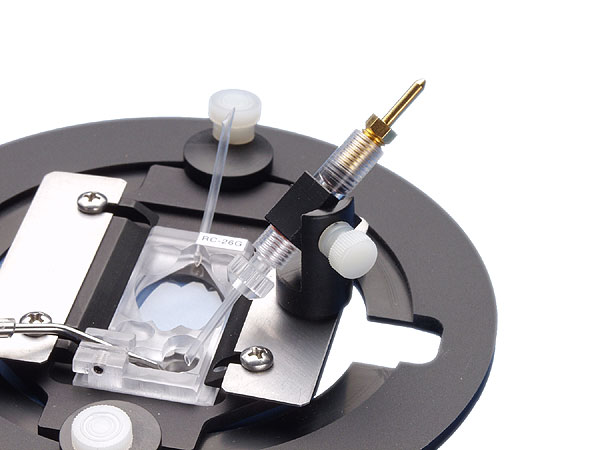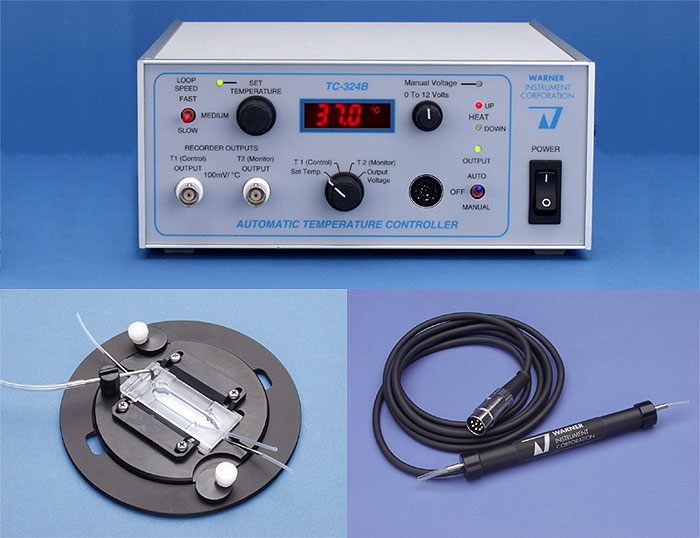Functional Overview of Series 20 Chambers
Product Summary
A common feature of Series 20 Imaging and Recording Chambers is the use of a disposable coverslip as the bottom of the chamber.
- View thru single coverslip
- Laminar perfusion flow
- Small volumes, fast fluid exchange
- Compatible with most microscopes
- Open and closed bath types
Series 20 Imaging and Recording Chambers are designed for electrophysiological recording and/or optical imaging. Applications include patch clamp, oocyte clamp, and other physiological measurements on cell cultures and tissue preparations.
Series 20 Recording chambers are a family of chambers designed to fill a large number of imaging and recording needs. The modular design consists of two parts; a polycarbonate chamber (insert) and an anodized aluminum platform (holder). The platform clamps the chamber providing a seal between the chamber and coverslip. Heater type platforms are used where chamber warming is required. The design of the platforms permits quick removal of the chamber for exchange of the coverslip. A variety of bath sizes and shapes are offered to provide a ready solution to many research requirements. Most models are stocked in depth for fast delivery.
Single Coverslip DesignA common feature of Series 20 chambers is the use of a disposable coverslip as the bottom or floor of the chamber. In many cases, this same coverslip will contain the cells to be studied. Thus, when used with an inverted microscope, the image is viewed through a single #1 coverslip thickness (nominally 0.15 mm). These chambers can also accomodate #1.5 thickness coverslips.
A diamond-shape bath is used in many Series 20 chambers (Models RC-22 through RC-26Z) to provide a linear solution flow. Studies performed at Yale and Stanford showed that this shape produced a laminar flow across the bath. The general shape and specific dimensions for each chamber are provided in the individual product page. In general, the lower the ratio of bath width (W) to length (L), the better the flow characteristics.
Models with small bath volumes can have exchange times measured in seconds, even with flow rates less than 1 ml/min. Newer models starting with the RC-27 use a slotted bath shape. These chambers are designed for slice studies and other applications requiring a large bath.
Perfusing the ChambersPerfusion can be pump-driven or gravity-fed. The VCS Perfusion Systems are gravity-based. Flow rates of 10 ml/min or greater are possible but flows of 0.5 to 5 ml/min are the norm.
Standard PE-160 (polyethylene) tubing, or equivalent, inserts directly into the chamber's input port. Solutions are removed by suction using either a vacuum source or pump. Open bath chambers are equipped with a stainless steel suction tube which is adjustable for control of solution height. Multiple perfusion lines can be connected to the chambers by using one of our MP or MPP Series manifolds.
Assembly of ChamberThe chamber is prepared by applying a thin bead of vacuum grease to the chamber bottom. We recommend using #1 painter's brushes, which are included in our new grease kit (111-Kit).The coverslip (sample side up) is then attached to the chamber. This assembly is placed into the platform and clamped to provide a seal between coverslip and chamber.
Mounting on the microscope is done with the appropriate stage adapter. The installation is completed by connecting the perfusion lines and any heater cabling required.
Related Products
Related Files
Customers from Europe and Australia can use the Multi Channel Systems - Online Shop to order Warner products or create quotes.
| Order No. | Model No. | Product Description | USA Price | Order |
|---|


